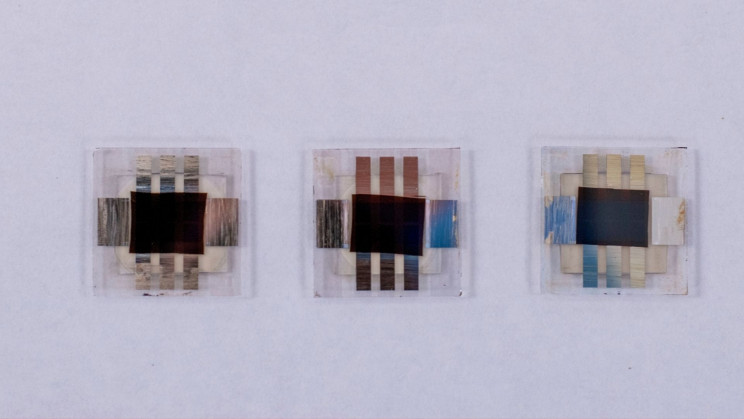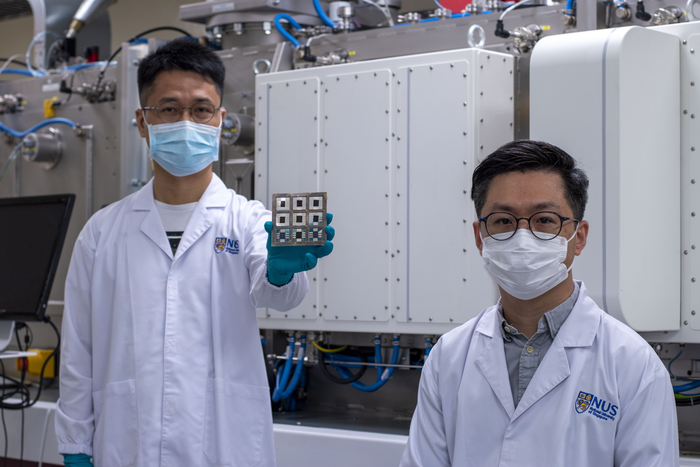New Organic tandem Solar Cell Design Can Boost Efficiency to 23,6%
Due to the large chemical composition and bandgap tunability of both perovskite and organic semiconductors, perovskite/organic tandem solar cells are attractive for next-generation thin-film photovoltaics. However, their efficiency is limited by the open-circuit voltage loss of wide-bandgap perovskite subcells and the non-ideal interconnecting layers. Here we report that the passivation of nickel oxide hole-transporting layers with benzylphosphonic acid leads to the suppression of interfacial recombination, boosting the voltage up to 1.26 V in a 1.79-eV-bandgap perovskite subcell. Then, we develop an optimized interconnecting layer structure based on a 4-nm-thick sputtered indium zinc oxide layer inserted between organic bathocuproine and molybdenum oxide with enhanced electrical properties and transmittance in the near-infrared region. Through these improvements, we achieve a maximum efficiency of 23.60% (22.95% certified) in the perovskite/organic tandem solar cell. In addition, the tandem device retained 90% initial efficiency after 500 h maximum power point tracking under continuous one sun illumination.

Solar cell technology comes to the forefront among other sustainable energy sources with its noteworthy growth in recent years. Their reliability, efficiency, durability, and price are crucial in terms of the commercial potential and large-scale implementation of solar energy projects around the world.
Recently, a research team from the National University of Singapore (NUS) reports that yet another record has been set in the power conversion efficiency of perovskite/organic tandem solar cells. The latest study of the team demonstrates that the solar cells performed 23.6% power conversion efficiency, which can be acknowledged as a significant leap forward considering the previous power conversion efficiency was about 21%. Thereby, this improvement in the efficiency of perovskite/organic tandem solar cells approaches the 26.7% power conversion rate of silicon solar cells, the dominating solar technology in the current solar photovoltaic (PV) market.
The lead researcher Presidential Young Professor Hou Yi, who is from the NUS Department of Chemical and Biomolecular Engineering and also leading a “Perovskite-based Multi-junction Solar Cells group” at the Solar Energy Research Institute of Singapore at NUS, tells: “Technologies for clean and renewable energy are extremely important for carbon reduction. Solar cells that directly convert solar energy into electricity are among the most promising clean energy technologies. The high power conversion efficiency of solar cells is critical for generating more electrical power using a limited area and this, in turn, reduces the total cost of generating solar energy.”
Stacking up
The conventional cells that are used in solar power plants are based on a single-junction architecture, the practical power conversion efficiency of which is limited to about 27% in industrial production. Therefore, pushing the limits of solar energy production will require new potentialities for solar cells to convert power more efficiently. It may require stacks of two or more absorber layers to raise the power conversion efficiency of solar cells to go beyond 30%. Accordingly, tandem solar cells consisting of two different types of photovoltaic materials is a hot area of research.
Assistant Professor Hou adds: “Our study shows the great potential of perovskite-based tandem solar cells for future commercial application of photovoltaic technology. Building on our new discovery, we hope to further improve the performance of our tandem solar cells and scale up this technology.”
Hou and his team have made new ground in the field of perovskite/organic tandem solar cells with their latest project. Their discovery paves the way for light and bendy thin-film tandem solar cells that have a wide range of areas of usage, including solar-powered blinds, automobiles, boats, and other mobile gadgets.
The analysis was published in Nature Energy.




0 Comments